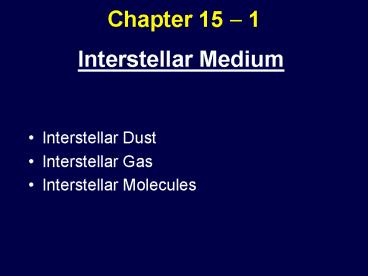Interstellar Medium - PowerPoint PPT Presentation
1 / 13
Title:
Interstellar Medium
Description:
http://www.kanidey.com/MoltingOfAGrammostolaRosea.ppt – PowerPoint PPT presentation
Number of Views:81
Avg rating:3.0/5.0
Title: Interstellar Medium
1
Chapter 15 ? 1
- Interstellar Medium
- Interstellar Dust
- Interstellar Gas
- Interstellar Molecules
2
The Interstellar Medium
The space between stars is not empty. It is
filled with atoms and molecules. This material is
collectively known as the interstellar matter.
The interstellar matter consists of initial
material left from the Big Bang and from material
that stars eject into space (stellar winds or
explosions).
Gas ? individual atoms and molecules ? accounts
for 99 of the interstellar matter.
3
What Is Cosmic Dust?
Small (10?8 ? 10?7 m) particles that
contain rocky cores rich in carbon or
silicates icy mantles of H2O, methane (CH4), or
ammonia (NH3).
Cosmic dust is frequently found in interstellar
clouds.
Cosmic dust is mostly formed in the interstellar
space from heavy elements produced inside stars.
4
How Does The Dust Look Like?
5
Colliding Stellar Winds
6
Properties of Cosmic Dust
- Absorbs high-energy radiation (UV, visible)
- Absorbs radiation selectively (the shorter the
wavelength, the higher the absorption) - Emits infrared radiation
- Resulting phenomena
- Interstellar reddening distant stars become
redder than close stars of the same temperature - Infrared cirrus emission from dusty clouds
- Linearly polarizes radiation
7
Interstellar Extinction
8
Wavelength Dependence
9
Interstellar Clouds
Some interstellar gas is concentrated into giant
interstellar clouds. The clouds collide with each
other, grow, and form new stars. Their lifetime
is long, but is much shorter than the age of the
Universe.
Examples of interstellar clouds The Horsehead
Nebula The Lagoon Nebula (M8) The Tarantula Nebula
10
Three States of Interstellar Gas
- Gas near hot stars ionized, temperature 10000 K
- A cloud of ionized hydrogen is called an HII
region. - HII regions only exist near hot stars and account
only for a small fraction of the interstellar
medium.
2. Clouds of neutral hydrogen. Cooler than HII
regions, far from stars, emit no visible spectral
lines, but produce radio emission. The strongest
spectral line of neutral hydrogen has a
wavelength of 21cm.
3. Very hot gas temperature million K. This
gas is heat by stellar explosions (supernova).
11
HII Regions
Stromgren sphere ? region around a star ionized
by its UV radiation.
? lt 91.2 nm ionizes H
Nuv(4?/3)Rs3nenH?(2)
For an O5 star, Rs?100pc
12
Interstellar Molecules
Discovered in the radio spectral region. Exist in
cold interstellar space. About 130 kinds of
interstellar molecules have been
discovered. Examples CN, CH, NH3, C6H6.
Molecules are formed in the atmospheres of cool
stars in the interstellar space
The chemical building blocks of life can form
even under very harsh conditions.
13
Molecular Masers
Microwave Amplification by Stimulated Emission of
Radiation































